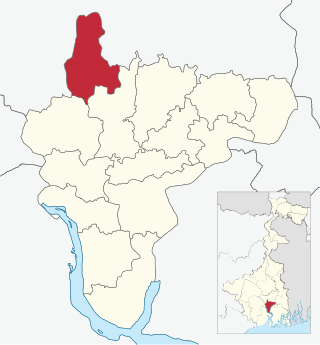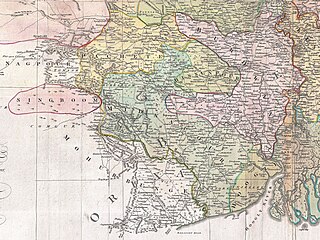Related Research Articles

Udaynarayanpur is a community development block that forms an administrative division in Uluberia subdivision of Howrah district in the Indian state of West Bengal.

Shyampur I is a community development block that forms an administrative division in Uluberia subdivision of Howrah district in the Indian state of West Bengal.

Bagnan I is a community development block that forms an administrative division in Uluberia subdivision of Howrah district in the Indian state of West Bengal.
Bauri (Bengali:বাউরী) is a community of indigenous people primarily residing in Bengal, and considered as one of the Scheduled Castes of India. The Bauris belong to the Bhil tribe. They are usually involved in activities like farming. The Bauris of Purbo Tila Moulvibazar in Bangladesh are usually involved in medicinal practices. The prime festivals they celebrate are known as Mansa Puja, Durga Puja and Kali Puja.

Mallabhum was the kingdom ruled by the Malla kings of Bishnupur, primarily in the present Bankura district in Indian state of West Bengal.
The Sauria Paharia people are a Dravidian ethnic people of Bangladesh and the Indian states of Jharkhand, West Bengal, and Bihar. They are found mostly in Santhal Parganas region in the Rajmahal Hills.
The Mal Paharia people are a Dravidian ethnic people of India, mainly living in the states of Jharkhand and West Bengal. They are the original inhabitants of the Rajmahal Hills, known today as the Santal Parganas division of Jharkhand. They are listed as a Scheduled Tribe by the governments of West Bengal, Bihar and Jharkhand. They speak the Malto language, a Dravidian language, as well as a poorly-documented Indo-Aryan Mal Paharia language.
Karmakar is a Bengali Hindu caste spread throughout West Bengal, Assam and Bangladesh. The Karmakars are traditionally blacksmiths by trade.They are one of the fourteen castes belonging to 'Nabasakh' group. They are recognized as Other Backward Class and also Forward Caste (General) by the Government of West Bengal.
Hambir Malla Dev was the forty-ninth king of Mallabhum. He ruled from 1565 to 1620 AD.

Panchla is a community development block that forms an administrative division in Howrah Sadar subdivision of Howrah district in the Indian state of West Bengal.

Uluberia I is a community development block that forms an administrative division in Uluberia subdivision of Howrah district in the Indian state of West Bengal.

Amta II is a community development block that forms an administrative division in Uluberia subdivision of Howrah district in the Indian state of West Bengal.

Bagnan II is a community development block that forms an administrative division in Uluberia subdivision of Howrah district in the Indian state of West Bengal.
Adi Malla, also known as Bagdi Raja, was the founder of the Mallabhum sometime in the 7th century CE.
Jay Malla, also known as Joy Malla & Jai Malla, was the son of Adi Malla, the founder of the Mallabhum.

Kalipada Singha Thakur was the last King of Malla dynasty of Bishnupur. He became King of Mallabhum in the year 1930 C.E.

Raghunath Malla Dev, also known as Raghunath Singha Dev, was the fifty-first king of the Mallabhum. He ruled from 1626 to 1656 CE.

Bir Singha Dev, also known as Beera Singha was the fifty-second king of the Mallabhum. He ruled from 1656 to 1682 CE.
Gopal Singha Dev II was the fifty-eighth king of the Mallabhum. He ruled from 1809 to 1876 CE.
Rajwar or Rajuar is a shifting cultivation community. The people of this community mainly live in Bihar, Jharkhand, Madhya Pradesh, Odisha and West Bengal. In Odisha, they are recognized as a Scheduled Tribe, while in Bihar, Jharkhand, and West Bengal, they are classified as Scheduled Caste. In other states, the community is considered part of the Other Backward Classes (OBC) or general population.
References
- ↑ "West Bengal, Census of India 2001, Data Highlights - The Scheduled Castes" (PDF). Office of the Registrar General, India. Retrieved 2009-06-28.
- ↑ "(SC)2011census". censusindia.gov.in.
- 1 2 Singh, Kumar Suresh (29 Aug 2008). The scheduled castes (2, illustrated ed.). Anthropological Survey of India, 1993. ISBN 9780195632545.
- ↑ Dasgupta, Biswas & Mallik 2009, p. 19.
- ↑ "Scheduled Caste List Of West Bengal State". anagrasarkalyan.gov.in. Archived from the original on 2015-03-08.
- ↑ "Scheduled Caste Welfare - List of Scheduled Castes". socialjustice.nic.in(Ministry of Social Justice and Empowerment). Archived from the original on 2012-09-13.
- ↑ "Scheduled Tribe List Of West Bengal State". anagrasarkalyan.gov.in. Archived from the original on 2009-08-29.
- ↑ "West Bengal, Census of India 2001, Data Highlights - The Scheduled Castes" (PDF). Office of the Registrar General, India. Retrieved 2009-06-28.
- Dasgupta, Gautam Kumar; Biswas, Samira; Mallik, Rabiranjan (2009), Heritage Tourism: An Anthropological Journey to Bishnupur, A Mittal Publication, p. 19, ISBN 978-8183242943
